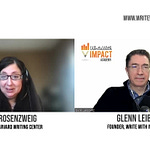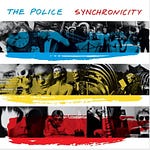
I’ll never forget writing essays during my freshman year at college. Since I had a roommate who tended to go to bed early, I would sit (uncomfortably) on the floor just outside of our room and painstakingly write, rewrite, and rewrite again the sentences that eventually, almost miraculously, turned into the papers on Shakespeare (in the fall semester) or Russian literature (in the spring semester) that I handed in.
I was considered what Jane Rosenzweig, Director of the Writing Center at Harvard College, calls a “one sentence at a timer”—someone who can’t move on to the next sentence until they get the current sentence just right. It’s a term that, in retrospect, describes how I wrote as a college student, but one I had never heard used until she mentioned it to me.
I was privileged to have the chance to talk to Jane and learn some of the writing strategies she shares with her time-starved, sleep-deprived students trying to get their assignments done and delivered (and to the exceedingly high standards that Harvard students typically set for themselves).
In her more than 20 years of teaching expository writing to thousands of students at Harvard, Jane has definitely seen all sorts of writers come through her office seeking help with their prose, including the “one sentence at a timers,” like I used to be (I’ve since broken out of that habit, thankfully).
In an excerpt from our conversation, which you can listen to in the podcast player in this post, Jane offers practical and tradition-busting advice for quickly crafting your first draft, for outlining without really outlining, and for using the writing process as a process of discovering what you really want to say.
In the full-version of the Writing Masterclass, Jane shares several more useful and inspiring tips like these, which I encourage you to check out by becoming a paying subscriber.
Jane also generously shares excellent writing tips in her Substack newsletter, “Writing Hacks,” which I recommend you subscribe to as well.
Here are just a few pieces of writing advice that Jane shared with me:
Pretend you’re not really writing
One of the strategies that I always recommend, and this is not unique to me, it's very common out there, is the “messy first draft.” This is how I write. I think that having a blank screen is very difficult and can really just paralyze you. And so, what I try to do is write as if I'm not actually writing whatever it is that I need to write. I'm just getting ideas on paper.
So you trick yourself in that way, so with the first draft, you're not really writing, you're just throwing everything you can think of on paper. We often call that a “messy first draft.” It doesn't need to be in any particular order, just all the things that you want to be talking about in whatever you're going to write. And then thinking about what you can do with that messy first draft, once you have it on the screen.
And at that point, it's helpful to think about outline. I never outline first, because then you're just staring at the blank screen, trying to take things one step at a time. But once you've written all the messy ideas from your head, then you can start to move them around and organize them and think about a kind of loose outline at that point.
Don’t write an outline: Do this instead
Some people are very comfortable outlining, but I think they often do it too formally, which is going to cost them time later. I learned outlining in this very formal way, with Roman numerals and letters and numbers. I've long ago thrown that out the window.
I think it's helpful to think about something that I often call a “flexible outline,” which is more like a list. Kind of in the same way as the messy first draft, just getting things on paper, but in list form, and then beginning to move that around and thinking about it.
What I worry about with outlining is the same thing I worry about with people who I call the “one sentence at a timers” — people who really can't move on from writing to any other part of a piece of writing until they've written perfect sentences. And so they're paralyzed for hours in that introduction, just rewriting those sentences.
You can do the same thing to yourself and an outline. If you're trying to figure out at the beginning of the writing process what order your ideas are going to come in, you're never going to get past that, because you shouldn't know yet that early in the writing process necessarily what order your ideas are going to come in.
Write until you know what to say
I had a great colleague in my early years at Harvard who would always tell her students “your first thoughts, aren't your best thoughts, they're just first.” And that always made me laugh, but it's also just great advice, right? Just because you came up with something when you were starting to write a draft and you put it in the first paragraph, doesn't mean that that's the thing that needs to stay in the first paragraph you needed to start there.
Any of us who've done a lot of writing have this experience, you’ve got to start somewhere, right? So you put something in the beginning and then often what people do is they write themselves to a better version of that, or they figure out as they're writing what they really want to be saying.
We talk a lot about writing as thinking. That's just one of those things that people say, but it really is. You often don't know what you really want to say until you start writing it down. And so I often have noticed both in my student writing and in writing when I'm working with people in the business world, that the thing that you really want to have at the beginning is the thing that you've ended up with at the end of that first draft.















Share this post